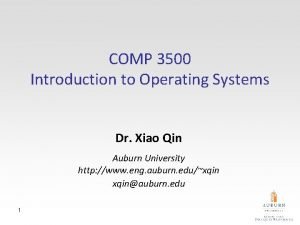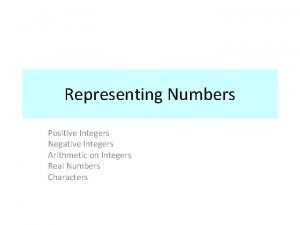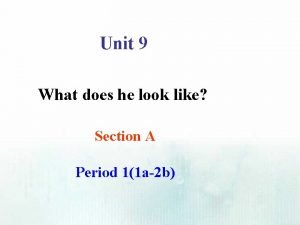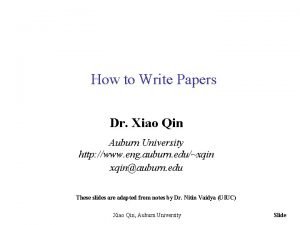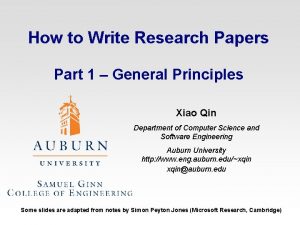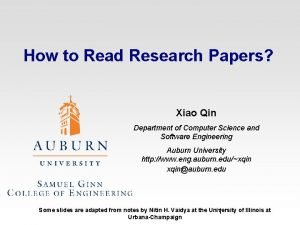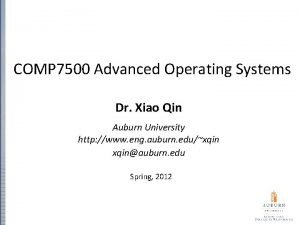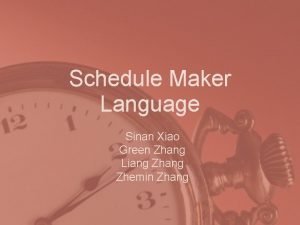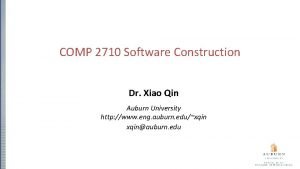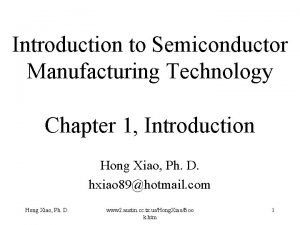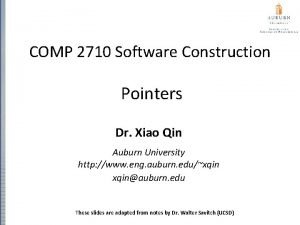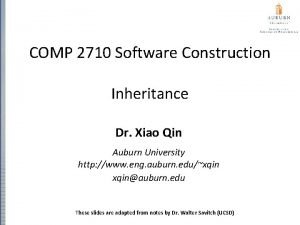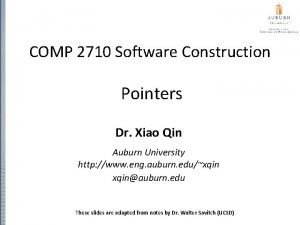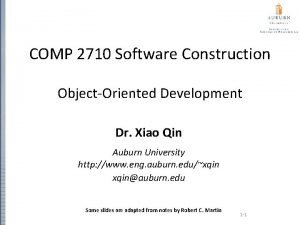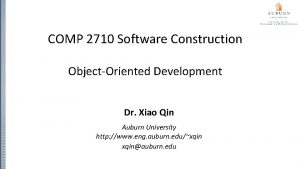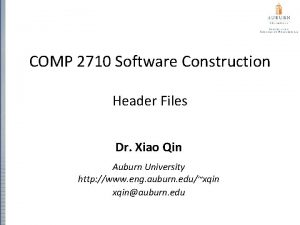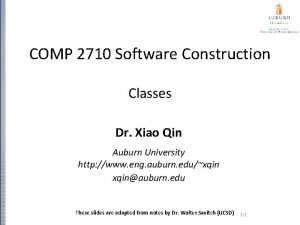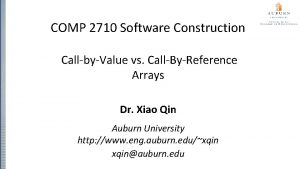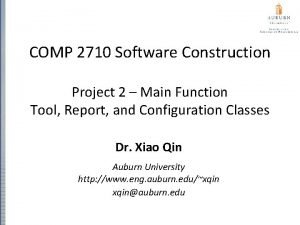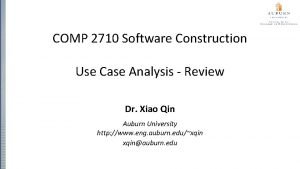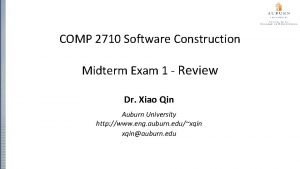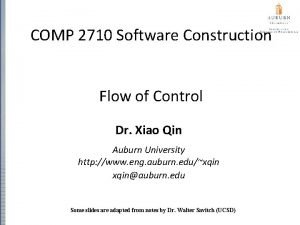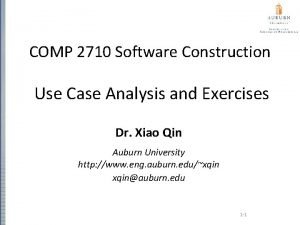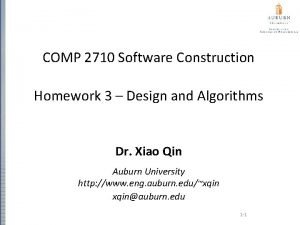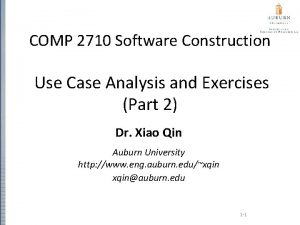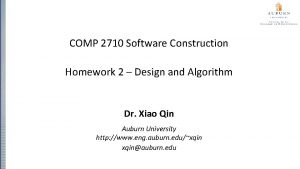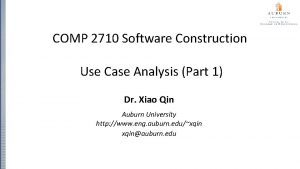COMP 2710 Software Construction Dynamic Arrays Dr Xiao



![Array Variables Pointers • Recall previous example: int a[10]; typedef int* Int. Ptr; Int. Array Variables Pointers • Recall previous example: int a[10]; typedef int* Int. Ptr; Int.](https://slidetodoc.com/presentation_image/2c92bf1a14fbbc2037bb62141da3a64f/image-4.jpg)
![Array Variables Pointers • Array variable int a[10]; • MORE than a pointer variable Array Variables Pointers • Array variable int a[10]; • MORE than a pointer variable](https://slidetodoc.com/presentation_image/2c92bf1a14fbbc2037bb62141da3a64f/image-5.jpg)


















- Slides: 23

COMP 2710 Software Construction Dynamic Arrays Dr. Xiao Qin Auburn University http: //www. eng. auburn. edu/~xqin@auburn. edu These slides are adapted from notes by Dr. Walter Savitch (UCSD)

Dynamic Arrays • Array variables – Really pointer variables! • Standard array – Fixed size • Dynamic array – Size not specified at programming time – Determined while program running Copyright © 2010 Pearson Addison-Wesley. All rights reserved. 10 -2

Array Variables • Recall: arrays stored in memory addresses, sequentially – Array variable "refers to" first indexed variable – So array variable is a kind of pointer variable! • Example: int a[10]; int * p; – a and p are both pointer variables! Copyright © 2010 Pearson Addison-Wesley. All rights reserved. 10 -3
![Array Variables Pointers Recall previous example int a10 typedef int Int Ptr Int Array Variables Pointers • Recall previous example: int a[10]; typedef int* Int. Ptr; Int.](https://slidetodoc.com/presentation_image/2c92bf1a14fbbc2037bb62141da3a64f/image-4.jpg)
Array Variables Pointers • Recall previous example: int a[10]; typedef int* Int. Ptr; Int. Ptr p; • a and p are pointer variables – Can perform assignments: p = a; // Legal. • p now points where a points – To first indexed variable of array a – a = p; // ILLEGAL! • Array pointer is CONSTANT pointer! Copyright © 2010 Pearson Addison-Wesley. All rights reserved. 10 -4
![Array Variables Pointers Array variable int a10 MORE than a pointer variable Array Variables Pointers • Array variable int a[10]; • MORE than a pointer variable](https://slidetodoc.com/presentation_image/2c92bf1a14fbbc2037bb62141da3a64f/image-5.jpg)
Array Variables Pointers • Array variable int a[10]; • MORE than a pointer variable – "const int *" type – Array was allocated in memory already – Variable a MUST point there…always! • Cannot be changed! • In contrast to ordinary pointers – Which can (& typically do) change Copyright © 2010 Pearson Addison-Wesley. All rights reserved. 10 -5

Dynamic Arrays • Array limitations – Must specify size first – May not know until program runs! • Must "estimate" maximum size needed – Sometimes OK, sometimes not – "Wastes" memory • Dynamic arrays – Can grow and shrink as needed Copyright © 2010 Pearson Addison-Wesley. All rights reserved. 10 -6

Creating Dynamic Arrays • Very simple! • Use new operator – Dynamically allocate with pointer variable – Treat like standard arrays • Example: typedef double * Double. Ptr; Double. Ptr d; d = new double[10]; //Size in brackets – Creates dynamically allocated array variable d, with ten elements, base type double Copyright © 2010 Pearson Addison-Wesley. All rights reserved. 10 -7

Deleting Dynamic Arrays • Allocated dynamically at run-time – So should be destroyed at run-time • Simple again. Recall Example: d = new double[10]; … //Processing delete [] d; – De-allocates all memory for dynamic array – Brackets indicate "array" is there – Recall: d still points there! • Should set d = NULL; Copyright © 2010 Pearson Addison-Wesley. All rights reserved. 10 -8

Function that Returns an Array • Array type NOT allowed as return-type of function • Example: int [] some. Function(); // ILLEGAL! • Instead return pointer to array base type: int* some. Function(); // LEGAL! Copyright © 2010 Pearson Addison-Wesley. All rights reserved. 10 -9

Pointer Arithmetic • Can perform arithmetic on pointers – "Address" arithmetic • Example: typedef double* Double. Ptr; Double. Ptr d; d = new double[10]; – d contains address of d[0] – d + 1 evaluates to address of d[1] – d + 2 evaluates to address of d[2] • Equates to "address" at these locations Copyright © 2010 Pearson Addison-Wesley. All rights reserved. 10 -10

Alternative Array Manipulation • Use pointer arithmetic! • "Step thru" array without indexing: for (int i = 0; i < array. Size; i++) cout << *(d + I) << " " ; • Equivalent to: for (int i = 0; i < array. Size; i++) cout << d[I] << " " ; • Only addition/subtraction on pointers – No multiplication, division • Can use ++ and -- on pointers Copyright © 2010 Pearson Addison-Wesley. All rights reserved. 10 -11

Multidimensional Dynamic Arrays • Yes we can! • Recall: "arrays of arrays" • Type definitions help "see it": typedef int* Int. Array. Ptr; Int. Array. Ptr *m = new Int. Array. Ptr[3]; – Creates array of three pointers – Make each allocate array of 4 ints • for (int i = 0; i < 3; i++) m[i] = new int[4]; – Results in three-by-four dynamic array! Copyright © 2010 Pearson Addison-Wesley. All rights reserved. 10 -12

Back to Classes • The -> operator – Shorthand notation • Combines dereference operator, *, and dot operator • Specifies member of class "pointed to" by given pointer • Example: My. Class *p; p = new My. Class; p->grade = "A"; Equivalent to: (*p). grade = "A"; Copyright © 2010 Pearson Addison-Wesley. All rights reserved. 10 -13

The this Pointer • Member function definitions might need to refer to calling object • Use predefined this pointer – Automatically points to calling object: Class Simple { public: void show. Stuff() const; private: int stuff; }; • Two ways for member functions to access: cout << stuff; cout << this->stuff; Copyright © 2010 Pearson Addison-Wesley. All rights reserved. 10 -14

Overloading Assignment Operator • Assignment operator returns reference – So assignment "chains" are possible – e. g. , a = b = c; • Sets a and b equal to c • Operator must return "same type" as it’s left-hand side – To allow chains to work – The this pointer will help with this! Copyright © 2010 Pearson Addison-Wesley. All rights reserved. 10 -15

Overloading Assignment Operator • Recall: Assignment operator must be member of the class – It has one parameter – Left-operand is calling object s 1 = s 2; • Think of like: s 1. =(s 2); • s 1 = s 2 = s 3; – Requires (s 1 = s 2) = s 3; – So (s 1 = s 2) must return object of s 1"s type • And pass to " = s 3"; Copyright © 2010 Pearson Addison-Wesley. All rights reserved. 10 -16

Overloaded = Operator Definition • Uses string Class example: String. Class& String. Class: : operator=(const String. Class& rt. Side) { if (this == &rt. Side) // if right side same as left side return *this; else { capacity = rt. Side. length; length = rt. Side. length; delete [] a; a = new char[capacity]; for (int I = 0; I < length; I++) a[I] = rt. Side. a[I]; return *this; } } Copyright © 2010 Pearson Addison-Wesley. All rights reserved. 10 -17

Shallow and Deep Copies • Shallow copy – Assignment copies only member variable contents over – Default assignment and copy constructors • Deep copy – Pointers, dynamic memory involved – Must dereference pointer variables to "get to" data for copying – Write your own assignment overload and copy constructor in this case! Copyright © 2010 Pearson Addison-Wesley. All rights reserved. 10 -18

Destructor Need • Dynamically-allocated variables – Do not go away until "deleted" • If pointers are only private member data – They dynamically allocate "real" data • In constructor – Must have means to "deallocate" when object is destroyed • Answer: destructor! Copyright © 2010 Pearson Addison-Wesley. All rights reserved. 10 -19

Destructors • Opposite of constructor – Automatically called when object is out-of-scope – Default version only removes ordinary variables, not dynamic variables • Defined like constructor, just add ~ – My. Class: : ~My. Class() { //Perform delete clean-up duties } Copyright © 2010 Pearson Addison-Wesley. All rights reserved. 10 -20

Copy Constructors • Automatically called when: 1. Class object declared and initialized to other object 2. When function returns class type object 3. When argument of class type is "plugged in" as actual argument to call-by-value parameter • Requires "temporary copy" of object – • Default copy constructor – • Copy constructor creates it Like default "=", performs member-wise copy Pointers write own copy constructor! Copyright © 2010 Pearson Addison-Wesley. All rights reserved. 10 -21

Summary 1 • Pointer is memory address – Provides indirect reference to variable • Dynamic variables – Created and destroyed while program runs • Freestore – Memory storage for dynamic variables • Dynamically allocated arrays – Size determined as program runs Copyright © 2010 Pearson Addison-Wesley. All rights reserved. 10 -22

Summary 2 • Class destructor – Special member function – Automatically destroys objects • Copy constructor – Single argument member function – Called automatically when temp copy needed • Assignment operator – Must be overloaded as member function – Returns reference for chaining Copyright © 2010 Pearson Addison-Wesley. All rights reserved. 10 -23
 Midterm exam (modules 1 - 9)
Midterm exam (modules 1 - 9) 2710 19 43
2710 19 43 Convert 2710 to another number in base three
Convert 2710 to another number in base three 2710 gtip
2710 gtip Dynamic arrays and amortized analysis
Dynamic arrays and amortized analysis Are vectors dynamic arrays
Are vectors dynamic arrays Angela xiao
Angela xiao Xiao ke tcm
Xiao ke tcm 13. how does he look like?
13. how does he look like? Xiao outline
Xiao outline Xiao qin auburn
Xiao qin auburn Scarlett xiao
Scarlett xiao 510631
510631 Xiao
Xiao Xiao qin auburn
Xiao qin auburn Xiao qin auburn
Xiao qin auburn Cunde xiao
Cunde xiao Nba schedule maker
Nba schedule maker Richard xiao
Richard xiao Xiao qin auburn
Xiao qin auburn Comgs
Comgs Introduction to semiconductor manufacturing technology
Introduction to semiconductor manufacturing technology Xiao animation
Xiao animation Lajin stretch
Lajin stretch
